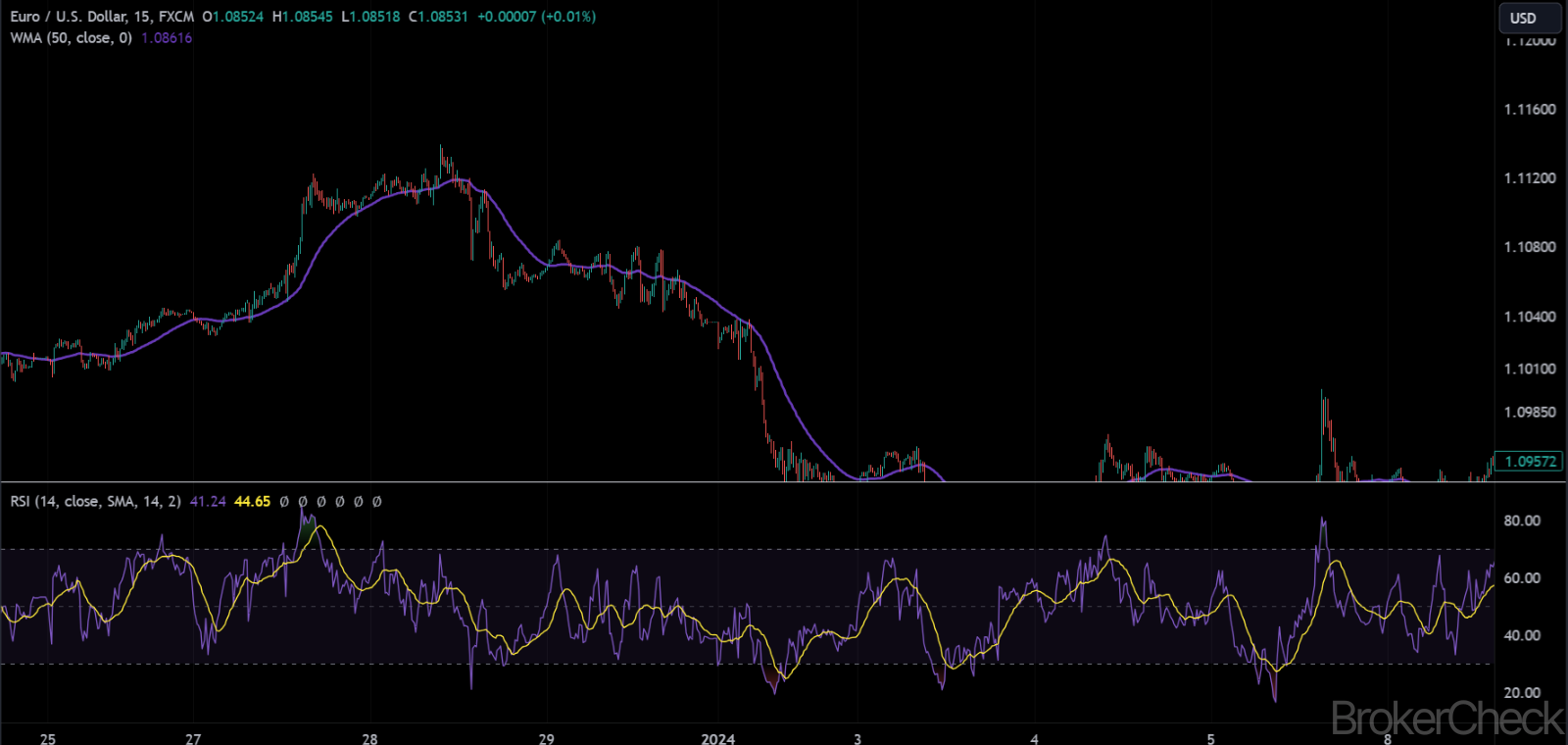1. Overview of the Weighted Moving Average (WMA)
The Weighted Moving Average (WMA) is a crucial technical indicator in financial analysis, especially in the field of trading. Unlike a simple moving average that assigns equal weight to all data points, the WMA gives more importance to recent prices. This characteristic makes the WMA a preferred tool for traders who need to track price trends while accounting for recent market movements. Understanding the WMA’s fundamental concepts, calculation method, and application is essential for both beginner and advanced traders in making informed trading decisions.

1.1. Basic Concept
The fundamental concept behind the WMA lies in its emphasis on more recent prices. This method involves assigning a heavier weighting to newer data points and a lesser weighting to older data. This weighting scheme allows the WMA to react more swiftly to price changes, making it a responsive indicator for analyzing price trends. Such a feature is particularly useful in volatile markets where recent price movements are more relevant for traders.
1.2. Importance in Technical Analysis
In technical analysis, the WMA is utilized to smooth out price data to help identify the direction of a trend. Its responsiveness to price changes makes it an essential tool for traders looking to enter or exit trades based on recent price trends. Additionally, the WMA can help in identifying support and resistance levels, which are vital for making strategic trading decisions.
| Aspect | Details |
| Definition | A technical indicator that averages prices over a period, emphasizing recent prices more heavily. |
| Key Feature | More responsive to recent price changes compared to a simple moving average. |
| Usefulness | Identifying trend directions, support and resistance levels. |
| Suitability | Both beginner and advanced traders in various market conditions. |
2. Calculation Process of the Weighted Moving Average
The calculation of the Weighted Moving Average (WMA) is a step-by-step process that involves assigning different weights to each price point within the chosen period. This section explains the methodology in detail, enabling traders to understand and potentially compute the WMA on their own.
2.1. Step-by-Step Calculation
The WMA is calculated using the following steps:
- Selecting the Time Period: Decide the number of periods to include in the WMA. Common periods are 10, 20, 50, or 100 days.
- Assigning Weights: Weights are assigned to each price point in the period. The most recent price gets the highest weight, and weights decrease linearly for older prices. For example, in a 10-day WMA, the most recent price is multiplied by 10, the next by 9, and so on, until the oldest price is multiplied by 1.
- Calculating the Weighted Total: Multiply each price by its respective weight and sum these values to get a weighted total.
- Sum of Weights: Calculate the sum of the weights used. In a 10-day WMA, this would be 1+2+3+…+10.
- Final WMA Calculation: Divide the weighted total by the sum of the weights to obtain the WMA.
2.2. Example
Consider a 5-day WMA with the following closing prices: Day 1 – $50, Day 2 – $52, Day 3 – $54, Day 4 – $53, Day 5 – $55. The calculation would be as follows:
- Weighted Total = (5*$55) + (4*$53) + (3*$54) + (2*$52) + (1*$50) = 275 + 212 + 162 + 104 + 50 = 803
- Sum of Weights = 1+2+3+4+5 = 15
- WMA = 803 / 15 ≈ 53.53
| Step | Details |
| 1. Time Period | Select the number of periods for the WMA (e.g., 10, 20, 50, 100 days). |
| 2. Assign Weights | Assign descending weights to prices, with the most recent price getting the highest weight. |
| 3. Weighted Total | Multiply each price by its weight and sum up these values. |
| 4. Sum of Weights | Calculate the total of the weights used. |
| 5. WMA Calculation | Divide the weighted total by the sum of the weights to find the WMA. |
3. Optimal Values for WMA Setup in Different Timeframes
Choosing the right period for the Weighted Moving Average (WMA) is crucial as it significantly influences its sensitivity and effectiveness. This section provides insights into selecting optimal WMA periods for different trading timeframes, catering to both short-term and long-term trading strategies.
3.1. Short-Term Trading
For short-term traders, such as day traders or scalpers, a WMA with a shorter period is preferred. Short-term WMAs react more quickly to price changes, making them suitable for capturing quick profit opportunities in fast-moving markets.
- Recommended Periods: 5 to 20 days.
- Advantages: High responsiveness to recent price movements, ideal for identifying short-term trends.
- Limitations: More prone to false signals due to market noise.
3.2. Medium-Term Trading
Medium-term traders, like swing traders, often prefer a balance between responsiveness and stability. A medium-range WMA provides this balance, offering a clearer view of the medium-term trend without as much noise as short-term WMAs.
- Recommended Periods: 20 to 50 days.
- Advantages: Balances sensitivity and stability, suitable for identifying medium-term trends and reversals.
- Limitations: Less responsive than short-term WMAs, potentially leading to delayed entry or exit signals.
3.3. Long-Term Trading
Long-term traders, such as position traders, benefit from using a WMA with a longer period. These WMAs provide a broader view of the market trend, essential for long-term trading strategies.
- Recommended Periods: 50 to 200 days.
- Advantages: Provides a clear view of the long-term trend, less affected by short-term market fluctuations.
- Limitations: Slow to react to new market trends, which can delay decision-making.

| Trading Term | Recommended Periods | Advantages | Limitations |
| Short-Term | 5 to 20 days | Quick responsiveness to price changes; ideal for short-term trends. | More prone to false signals due to market noise. |
| Medium-Term | 20 to 50 days | Balances sensitivity and stability; suitable for medium-term trends. | Less responsive, potentially delayed signals. |
| Long-Term | 50 to 200 days | Clear view of long-term trends; less affected by short-term fluctuations. | Slow reaction to new trends; delayed decision-making. |
4. Interpretation of the Weighted Moving Average
Interpreting the Weighted Moving Average (WMA) correctly is key to utilizing it effectively in trading strategies. This section discusses various ways to interpret the WMA, focusing on trend identification, potential buy/sell signals, and understanding market sentiment.
4.1. Trend Identification
The primary use of the WMA is to identify the direction of the market trend. A rising WMA indicates an uptrend, suggesting bullish market sentiment, whereas a declining WMA signals a downtrend, indicative of bearish sentiment. Traders often look for the slope of the WMA as an early indicator of trend changes.
4.2. Buy and Sell Signals
WMAs can also be used to generate potential buy and sell signals:
- Buy Signal: A buy signal is suggested when the price moves above the WMA, indicating that the asset might be gaining bullish momentum.
- Sell Signal: Conversely, a sell signal is indicated when the price falls below the WMA, suggesting bearish momentum.
4.3. Crossovers
Crossovers between short-term and long-term WMAs provide significant trading signals. A crossover occurs when a short-term WMA crosses above (bullish crossover) or below (bearish crossover) a long-term WMA. These crossovers can indicate potential trend reversals.

4.4. Support and Resistance
The WMA can act as a dynamic level of support and resistance. In an uptrend, the WMA often serves as support, while in a downtrend, it can act as resistance. Prices tend to bounce off these dynamic levels, offering trading opportunities.
| Interpretation Type | Description | Trading Implications |
| Trend Identification | Direction of the WMA indicates market trend (upward or downward). | Helps in aligning trades with the market trend. |
| Buy/Sell Signals | Price crossing above/below the WMA suggests potential buy/sell opportunities. | Useful for timing entries and exits. |
| Crossovers | Short-term WMA crossing over the long-term WMA. | Indicates potential trend reversals. |
| Support and Resistance | The WMA acts as a dynamic support or resistance level. | Provides levels for potential bounce-offs or breakouts. |
5. Combining the Weighted Moving Average with Other Indicators
To enhance trading strategies and improve decision-making, traders often combine the Weighted Moving Average (WMA) with other technical indicators. This section explores effective combinations of the WMA with various indicators, highlighting how these combinations can offer more comprehensive market insights.
5.1. WMA and Moving Average Convergence Divergence (MACD)
Combining the WMA with the Moving Average Convergence Divergence (MACD) can provide a powerful analysis tool. The WMA helps in identifying the trend direction, while the MACD, a momentum indicator, can signal strength, direction, and duration of the trend.
- Application: Use WMA for trend identification and MACD for confirming trend strength and potential reversals.
5.2. WMA and Relative Strength Index (RSI)
The Relative Strength Index (RSI) is a momentum oscillator that measures the speed and change of price movements. Combining the WMA with the RSI allows traders to spot potential trend reversals and overbought or oversold conditions.
- Application: Utilize the WMA to determine the market trend and use RSI to identify potential reversal points based on overbought or oversold conditions.
5.3. WMA and Bollinger Bands
Bollinger Bands are a volatility indicator that consists of a middle band (usually a simple moving average) and two standard deviation bands above and below it. Integrating the WMA with Bollinger Bands can help in identifying volatility changes within a trend.
- Application: Use the WMA to track the trend and Bollinger Bands to understand market volatility and potential breakout points.
5.4. WMA and Stochastic Oscillator
The Stochastic Oscillator compares a particular closing price of an asset to a range of its prices over a certain period. This combination allows traders to corroborate trend signals (from the WMA) with momentum signals (from the Stochastic Oscillator).
- Application: Use the WMA for trend direction and the Stochastic Oscillator to identify momentum shifts that could indicate entry or exit points.
| Indicator Combination | Description | Application |
| WMA + MACD | Combines trend identification (WMA) with trend strength and duration (MACD). | Confirming trend strength and potential reversals. |
| WMA + RSI | Integrates trend analysis (WMA) with momentum and overbought/oversold conditions (RSI). | Identifying potential trend reversals and market extremes. |
| WMA + Bollinger Bands | Merges trend tracking (WMA) with volatility analysis (Bollinger Bands). | Understanding market volatility and identifying breakout points. |
| WMA + Stochastic Oscillator | Combines trend direction (WMA) with momentum and price range analysis (Stochastic Oscillator). | Corroborating trend signals with momentum shifts for entry/exit points. |
6. Incorporating the Weighted Moving Average into Risk Management
Effective risk management is crucial in trading, and the Weighted Moving Average (WMA) can play a significant role in this regard. This section outlines strategies for using the WMA to manage and mitigate trading risks, ensuring a more disciplined and systematic approach to trading.
6.1. Setting Stop Loss and Take Profit Levels
One of the primary ways to use the WMA in risk management is by setting stop loss and take profit levels. The WMA can act as a dynamic level for these orders, adapting to changing market conditions.
- Stop Loss: Set stop loss orders slightly below the WMA in an uptrend or above it in a downtrend. This method helps in minimizing losses if the market reverses direction.
- Take Profit: Place take profit orders near potential resistance levels in an uptrend or support levels in a downtrend, as indicated by the WMA.
6.2. Position Sizing
Adjusting position size based on the strength of the WMA signal can be an effective risk management strategy. Stronger signals (e.g., clear crossovers or significant divergence from price) might warrant larger position sizes, whereas weaker signals may call for more caution.
6.3. Diversification and Hedging
Using the WMA to inform diversification and hedging strategies can further reduce risk. For instance, if the WMA signals a strong trend in one asset, traders might consider diversifying into assets that are not correlated or inversely correlated to this trend as a hedge.
6.4. Managing Leverage
The WMA can also guide decisions on leverage. In situations where the WMA indicates a stable trend, traders might be more confident in using leverage. Conversely, in uncertain or highly volatile market conditions (as indicated by rapid WMA shifts), reducing or avoiding leverage can be prudent.
| Risk Management Strategy | Description | Application |
| Setting Stop Loss and Take Profit | Using the WMA to determine dynamic stop loss and take profit levels. | Minimizing losses and securing profits in line with market trends. |
| Position Sizing | Adjusting trade size based on the strength of the WMA signal. | Balancing risk and reward according to signal reliability. |
| Diversification and Hedging | Informing diversification and hedging decisions based on WMA trends. | Reducing overall portfolio risk. |
| Managing Leverage | Guiding leverage use based on WMA trend stability. | Optimizing leverage in different market conditions. |













